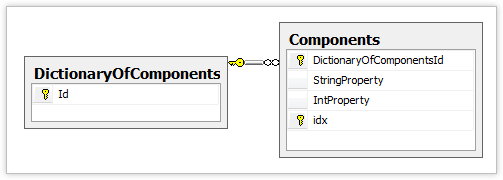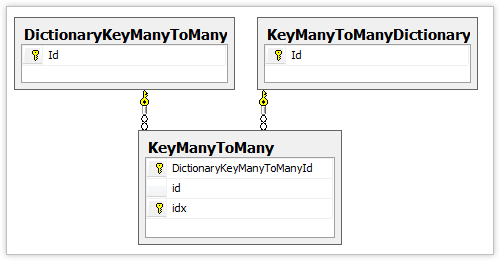NHibernate3剖析:Mapping篇之集合映射基础(4):Map映射
2010-05-12 21:56 李永京 阅读(6934) 评论(17) 编辑 收藏 举报本节内容
系列引入
NHibernate3.0剖析系列分别从Configuration篇、Mapping篇、Query篇、Session策略篇、应用篇等方面全面揭示NHibernate3.0新特性和应用及其各种应用程序的集成,基于NHibernte3.0版本。如果你还不熟悉NHibernate,可以快速阅读NHibernate之旅系列文章导航系列入门,如果你已经在用NHibernate了,那么请跟上NHibernate3.0剖析系列吧。
- NHibernate专题:http://kb.cnblogs.com/zt/nhibernate/
- NHibernate官方站点:http://nhforge.org/
- NHibernate参考文档:http://nhforge.org/doc/nh/en/
- 获取NHibernate地址:http://sourceforge.net/projects/nhibernate/
Dictionary映射
这节我们介绍Dictionary映射,一般而言,Domain中的System.Collections.Generic.IDictionary<TKey,TValue>集合类型使用Map来映射。
映射纲要
Map映射有三个部分:集合外键(Collection foreign keys)、索引字段(index column)、集合元素(Collection element)。
集合外键(Collection foreign keys),通过<key>映射,其column属性命名方式一般采用"集合持有者类名+Id"命名方式。
索引字段(index column),即字典的键:
- 值类型,通过<map-key>或者<composite-map-key>映射。
- 引用类型,通过<map-key-many-to-many>映射。
集合元素(Collection element),即字典的值:
- 值类型,其声明周期完全依赖于集合持有者,通过<element>或<composite-element>映射。
- 引用类型,被作为集合持有的状态考虑的,只有两个对象之间的“连接”,具有其自己的生命周期,通过<one-to-many>或<many-to-many>映射。
案例分析
案例一:DictionaryOfElements
Domain定义中,集合元素一般是单一元素(Elements)类型,即.Net基本类型(string、int、double等等)。
//Code Snippets Copyright http://lyj.cnblogs.com/
public class DictionaryOfElements
{
public int Id { get; set; }
public IDictionary<string, DateTime> Elements { get; set; }
}
映射简单写法:
//Code Snippets Copyright http://lyj.cnblogs.com/
<class name="DictionaryOfElements">
<id name="Id" type="Int32">
<generator class="hilo" />
</id>
<map name="Elements" table="DictionaryOfElementsElements">
<key column="DictionaryOfElementsId" />
<map-key type="String" />
<element type="DateTime" />
</map>
</class>
字典的键使用<map-key>映射,我们必须指定type,其column缺省列名为idx。
字典的值为单一元素类型,这时使用<element>映射,我们应该至少type类型,其column缺省列名为id。
数据库架构:
案例二:DictionaryOfComponents
Domain定义中,集合元素一般是组件(Component)类型,也就是值类型。
//Code Snippets Copyright http://lyj.cnblogs.com/
public class DictionaryOfComponents
{
public int Id { get; set; }
public IDictionary<string, ComponentDictionary> Components { get; set; }
}
public class ComponentDictionary
{
public string StringProperty { get; set; }
public int IntProperty { get; set; }
}
映射简单写法:
//Code Snippets Copyright http://lyj.cnblogs.com/
<class name="DictionaryOfComponents">
<id name="Id" type="Int32">
<generator class="hilo" />
</id>
<map name="Components">
<key column="DictionaryOfComponentsId" />
<map-key type="String" />
<composite-element class="ComponentDictionary">
<property name="StringProperty" />
<property name="IntProperty" />
</composite-element>
</map>
</class>
字典的键使用<map-key>映射,我们必须指定type,其column缺省列名为idx。
字典的值为组件(Component)类型,使用composite-element映射,需要指明组件类名,然后映射其组件属性。
数据库架构:
案例三:DictionaryOfOneToMany
Domain定义中,集合元素是指向另一个实体OneToManyDictionary的引用。这里设置为一对多关系。
//Code Snippets Copyright http://lyj.cnblogs.com/
public class DictionaryOfOneToMany
{
public int Id { get; set; }
public IDictionary<string, OneToManyDictionary> OneToMany { get; set; }
}
public class OneToManyDictionary
{
public int Id { get; set; }
}
映射简单写法:
//Code Snippets Copyright http://lyj.cnblogs.com/
<class name="DictionaryOfOneToMany">
<id name="Id" type="Int32">
<generator class="hilo" />
</id>
<map name="OneToMany">
<key column="DictionaryOfOneToManyId" />
<map-key type="String" />
<one-to-many class="OneToManyDictionary" />
</map>
</class>
<class name="OneToManyDictionary">
<id name="Id" type="Int32">
<generator class="hilo" />
</id>
</class>
字典的键使用<map-key>映射,我们必须指定type,其column缺省列名为idx。
字典的值是引用类型,DictionaryOfOneToMany和OneToManyDictionary定义一对多关系,使用<one-to-many>映射,指明关联的对象。
数据库架构:
案例四:DictionaryOfManyToMany
Domain定义中,集合元素是指向另一个实体ManyToManyDictionary的引用。这里设置为多对多关系。
//Code Snippets Copyright http://lyj.cnblogs.com/
public class DictionaryOfManyToMany
{
public int Id { get; set; }
public IDictionary<string, ManyToManyDictionary> ManyToMany { get; set; }
}
public class ManyToManyDictionary
{
public int Id { get; set; }
}
映射简单写法:
//Code Snippets Copyright http://lyj.cnblogs.com/
<class name="DictionaryOfManyToMany">
<id name="Id" type="Int32">
<generator class="hilo" />
</id>
<map name="ManyToMany">
<key column="DictionaryOfManyToManyId" />
<map-key type="String" />
<many-to-many class="ManyToManyDictionary" column="ManyToManyDictionaryId" />
</map>
</class>
<class name="ManyToManyDictionary">
<id name="Id" type="Int32">
<generator class="hilo" />
</id>
</class>
字典的键使用<map-key>映射,我们必须指定type,其column缺省列名为idx。
字典的值为引用类型,我们设置多对多关系,这时需要一个“中间表”来存储这两个对象的关系。
数据库架构:
案例五:DictionaryKeyManyToMany
Domain定义中,集合Key是指向另一个实体ManyToManyDictionary的引用。这里设置为多对多关系。
//Code Snippets Copyright http://lyj.cnblogs.com/
public class DictionaryKeyManyToMany
{
public int Id { get; set; }
public IDictionary<KeyManyToManyDictionary, string> KeyManyToMany { get; set; }
}
public class KeyManyToManyDictionary
{
public int Id { get; set; }
}
映射简单写法:
//Code Snippets Copyright http://lyj.cnblogs.com/
<class name="DictionaryKeyManyToMany">
<id name="Id" type="Int32">
<generator class="hilo" />
</id>
<map name="KeyManyToMany">
<key column="DictionaryKeyManyToManyId" />
<map-key-many-to-many class="KeyManyToManyDictionary" />
<element type="String" />
</map>
</class>
<class name="KeyManyToManyDictionary">
<id name="Id" type="Int32">
<generator class="hilo" />
</id>
</class>
字典的键为引用类型,我们设置多对多关系,使用<map-key-many-to-many>映射,并指明class名。
字典的值为为单一元素类型,使用<element>映射。
数据库架构:
结语
这篇文章介绍NHibernate中的集合映射之Dictionary映射。结合前面三篇一起总结了NHibernate中四种集合的映射基础,有人会问这四篇代码看起来基本差不多,其实不是这样的,每种案例都是一个特殊的Domain应用,因为在我了解中,大多数人设计Domain还是十分简单,没有什么复杂的结构,有的甚至为了赶项目,找个生成工具生成比较糟蹋的Mapping,自己对Mapping还搞不清生成出来的Mapping代码,于是到处询问,贴出那些生成出来的代码,说实话,这非常反感。我们应该学会NHibernate的基本映射,所以我总结按其分类一一举例,并写出比较正规的Mapping,需要给大家有所指引和参考。
接下来开始从应用角度分析它们的不同。
希望本文对你有所帮助。






